
The Partition of India in 1947 was the change of political borders and the division of other assets that accompanied the dissolution of the British Raj in the Indian subcontinent and the creation of two independent dominions in South Asia: India and Pakistan. The Dominion of India is today the Republic of India, and the Dominion of Pakistan—which at the time comprised two regions lying on either side of India—is now the Islamic Republic of Pakistan and the People's Republic of Bangladesh. The partition was outlined in the Indian Independence Act 1947. The change of political borders notably included the division of two provinces of British India, Bengal and Punjab. The majority Muslim districts in these provinces were awarded to Pakistan and the majority non-Muslim to India. The other assets that were divided included the British Indian Army, the Royal Indian Navy, the Royal Indian Air Force, the Indian Civil Service, the railways, and the central treasury. Provisions for self-governing independent Pakistan and India legally came into existence at midnight on 14 and 15 August 1947 respectively.

Huseyn Shaheed Suhrawardy was a Pakistani Bengali barrister and politician. In Bangladesh, Suhrawardy is remembered as a pioneer of Bengali civil rights movements, later turned into Bangladesh independence movement, and the mentor of Bangladesh's founding leader Sheikh Mujibur Rahman. He is also remembered for his performance as the Minister for Civil Supply during the Bengal famine of 1943. In India, he is seen as a controversial figure; indirectly responsible for the 1946 Calcutta Killings.

The Bengali language movement was a political movement in former East Bengal in 1952, advocating the recognition of the Bengali language as a co-lingua franca of the then-Dominion of Pakistan to allow its use in government affairs, the continuation of its use as a medium of education, its use in media, currency and stamps, and to maintain its writing in the Bengali script.

Abul Kasem Fazlul Huq, popularly known as Sher-e-Bangla, was a Bengali lawyer and politician who presented the Lahore Resolution which had the objective of creating an independent Pakistan. He also served as the first and longest Prime Minister of Bengal during the British Raj.

The first Partition of Bengal (1905) was a territorial reorganization of the Bengal Presidency implemented by the authorities of the British Raj. The reorganization separated the largely Muslim eastern areas from the largely Hindu western areas. Announced on 16 July 1905 by Lord Curzon, then Viceroy of India, and implemented West Bengal for Hindus and East Bengal for Muslims, it was undone a mere six years later. The nationalists saw the partition as a challenge to Indian nationalism and as a deliberate attempt to divide the Bengal Presidency on religious grounds, with a Muslim majority in the east and a Hindu majority in the west. The Hindus of West Bengal complained that the division would make them a minority in a province that would incorporate the province of Bihar and Orissa. Hindus were outraged at what they saw as a "divide and rule" policy, even though Curzon stressed it would produce administrative efficiency. The partition animated the Muslims to form their own national organization along communal lines. To appease Bengali sentiment, Bengal was reunited by King George V in 1911, in response to the Swadeshi movement's riots in protest against the policy.

The Partition of Bengal in 1947, also known as the Second Partition of Bengal, part of the Partition of India, divided the British Indian Bengal Province along the Radcliffe Line between the Dominion of India and the Dominion of Pakistan. The Bengali Hindu-majority West Bengal became a state of India, and the Bengali Muslim-majority East Bengal became a province of Pakistan.
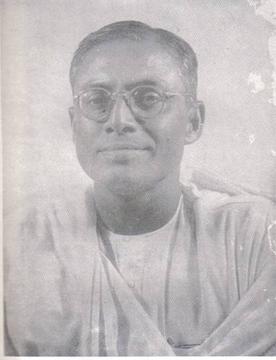
Bhupendra Kumar Dutta was an Indian freedom fighter and a revolutionary who fought for Indian independence from British rule. In addition to his other specific contributions as a Jugantar leader, he holds the record of a hunger strike for 78 days in Bilaspur Jail in December 1917.

Dhirendranath Datta was a Bengali lawyer by profession who was also active in the politics of undivided Bengal in pre-partition India, and later in East Pakistan (1947–1971).
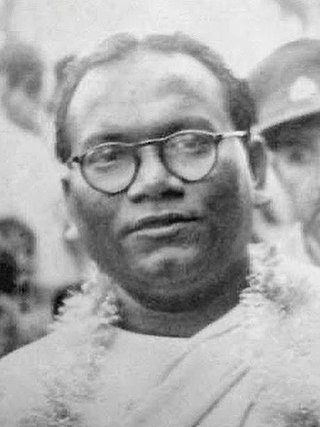
Jogendranath Mandal emerged as a prominent figure among the architects of the nascent state of Pakistan. He served as the inaugural Minister of Law and Labour, as well as the subsequent Minister of Commonwealth and Kashmir Affairs. Within the Interim Government of India, he had previously held the portfolio of law. Distinguished as a leader representing the Scheduled Castes (Dalits), Mandal vehemently opposed the partition of Bengal in 1947. His rationale rested on the apprehension that a divided Bengal would subject the Dalits to the dominance of the majority caste-Hindus in West Bengal (India) and Assam. Eventually opting to maintain his base in East Pakistan, Mandal aspired for the welfare of the Dalits and assumed a ministerial role in Pakistan as the Minister of Law and Labour. However, a few years subsequent to the partition, he relocated to India, tendering his resignation to Liaquat Ali Khan, the then Prime Minister of Pakistan, citing the perceived anti-Dalit bias within the Pakistani administration.

Bengali nationalism is a form of nationalism that focuses on Bengalis as a single ethnicity by rejecting imposition of other languages and cultures while promoting its own in Bengal. Bengalis speak the Bengali language and mostly live across Bangladesh and the Indian states of West Bengal, Tripura and Assam. Bengali nationalism is one of the four fundamental principles according to the Constitution of Bangladesh and was the main driving force behind the creation of the independent nation state of Bangladesh through the 1971 liberation war. Bengali Muslims make up the majority (90%) of Bangladesh's citizens (Bangladeshis), and are the largest minority in the Indian states of Assam and West Bengal, whereas Bengali Hindus make up the majority of India's citizens (Indians) in Indian states of West Bengal and Tripura, and are the largest minority in the Indian states of Assam and Jharkhand and the independent state of Bangladesh (8%).
United Bengal was a proposal to transform Bengal Province into an undivided, sovereign state at the time of the Partition of India in 1947. It sought to prevent the division of Bengal on religious grounds. The proposed state was to be called the Free State of Bengal. A confessionalist political system was mooted. The proposal was not put up for a vote. The British government proceeded to partition Bengal in accordance with the Mountbatten Plan and Radcliffe Line.
The United Nations categorizes Bangladesh as a moderate democratic Muslim country. Sunni Islam is the largest religion in the country and in all of its districts, except Rangamati. The Constitution of Bangladesh refers to Islam twice: the document begins with the Islamic phrase Bismillahir Rahmanir Raheem and article (2A), added later, declares that: "Islam is the state religion of the republic".

The Krishak Sramik Party was a major anti-feudal political party in the British Indian province of Bengal and later in the Dominion of Pakistan's East Bengal and East Pakistan provinces. It was founded in 1929 as the Nikhil Banga Praja Samiti to represent the interests of tenant farmers in Bengal's landed gentry estates. Sir Abdur Rahim was its first leader. A. K. Fazlul Huq was elected leader in 1935 when the former was appointed as the president of the Central Legislative Assembly of India. In 1936, it took the name of Krishak Praja Party and contested the 1937 election. The party formed the first government in the Bengal Legislative Assembly. After the partition of British India, it was reorganized as the Krishak Sramik Party to contest the 1954 election, as part of the United Front. The coalition won the election and formed the provincial government in the East Bengal Legislative Assembly.

Bengali Hindus are an ethnoreligious population who make up the majority in the Indian states of West Bengal, Tripura, Andaman and Nicobar Islands, Jharkhand, and Assam's Barak Valley region. In Bangladesh, they form the largest minority. They are adherents of Hinduism and are native to the Bengal region in the eastern part of the Indian subcontinent. Comprising about one-third of the global Bengali population, they are the second-largest ethnic group among Hindus after Hindustani Hindus. Bengali Hindus speak Bengali, which belongs to the Indo-Aryan language family and adhere to Shaktism or Vaishnavism of their native religion Hinduism with some regional deities. There are significant numbers of Bengali-speaking Hindus in different Indian states. According to the census in 1881, 12.81 per cent of Bengali Hindus belonged to the three upper castes while the rest belonged to the Shudra and Dalit castes.
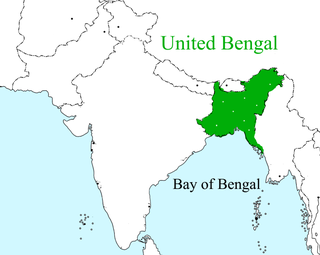
Greater Bangladesh, or Greater BanglaalsoGreater Bengal is the irredentist ideology of Bangladesh to inevitably expand its territory to include the Indian states that currently has, or historically had, large populations of ethnic Bengali people. These include West Bengal, Bihar, Odisha, and Jharkhand to the west, Sikkim to the north, and the states of Arunachal Pradesh, Assam, Meghalaya, Tripura, Mizoram, Manipur, and Nagaland to the east. Greater Bangladesh would naturally therefore take on the more inclusive title of Greater Bengal, as her people would be united under a common ethnicity and heritage based on language rather than one based on religion.
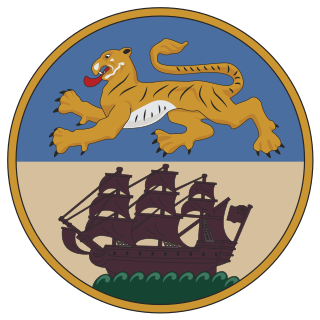
The prime minister of Bengal was the head of government of Bengal Province and the Leader of the House in the Bengal Legislative Assembly in British India. The position was dissolved upon the Partition of Bengal during the partition of India in 1947.

The Bengal Legislative Assembly was the largest legislature in British India, serving as the lower chamber of the legislature of Bengal. It was established under the Government of India Act 1935. The assembly played an important role in the final decade of undivided Bengal. The Leader of the House was the Prime Minister of Bengal. The assembly's lifespan covered the anti-feudal movement of the Krishak Praja Party, the period of World War II, the Lahore Resolution, the Quit India movement, suggestions for a United Bengal and the partition of Bengal and partition of British India.
Jnanendra Chandra Majumdar was an anti-colonial Bengali politician, and a representative of East Pakistan to the Constituent Assembly of Pakistan.
Anarchism in Bangladesh has its roots in the ideas of the Bengali Renaissance and began to take influence as part of the revolutionary movement for Indian independence in Bengal. After a series of defeats of the revolutionary movement and the rise of state socialist ideas within the Bengali left-wing, anarchism went into a period of remission. This lasted until the 1990s, when anarchism again began to reemerge after the fracturing of the Communist Party of Bangladesh, which led to the rise of anarcho-syndicalism among the Bangladeshi workers' movement.
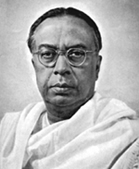
Kiran Shankar Roy, also credited as Kiron Sankar Roy was an Indian Bengali politician, academic, and freedom fighter. He was one of the leading figures of the Swaraj Party in the anti-British independence movement of the Indian subcontinent and one-time colleague of Subhas Chandra Bose and associate of Sarat Chandra Bose. He was one of Bengal's big five prominent Congress leaders during the two decades 1920s and 1940s. Roy, Leader of the Congress Parliamentary Party in the Bengal Assembly, participated in the United Independent Bengal movement of 1947















